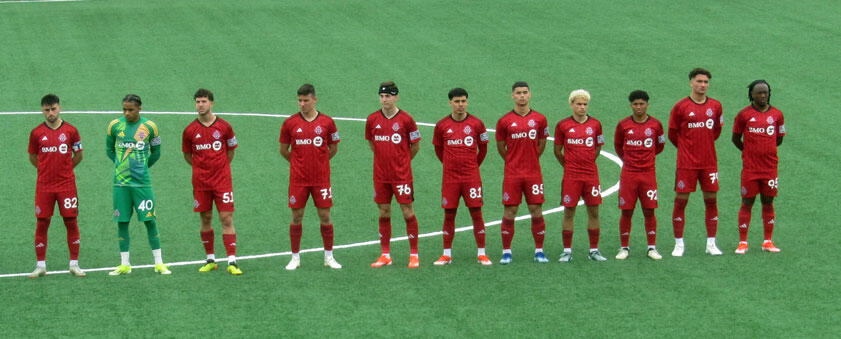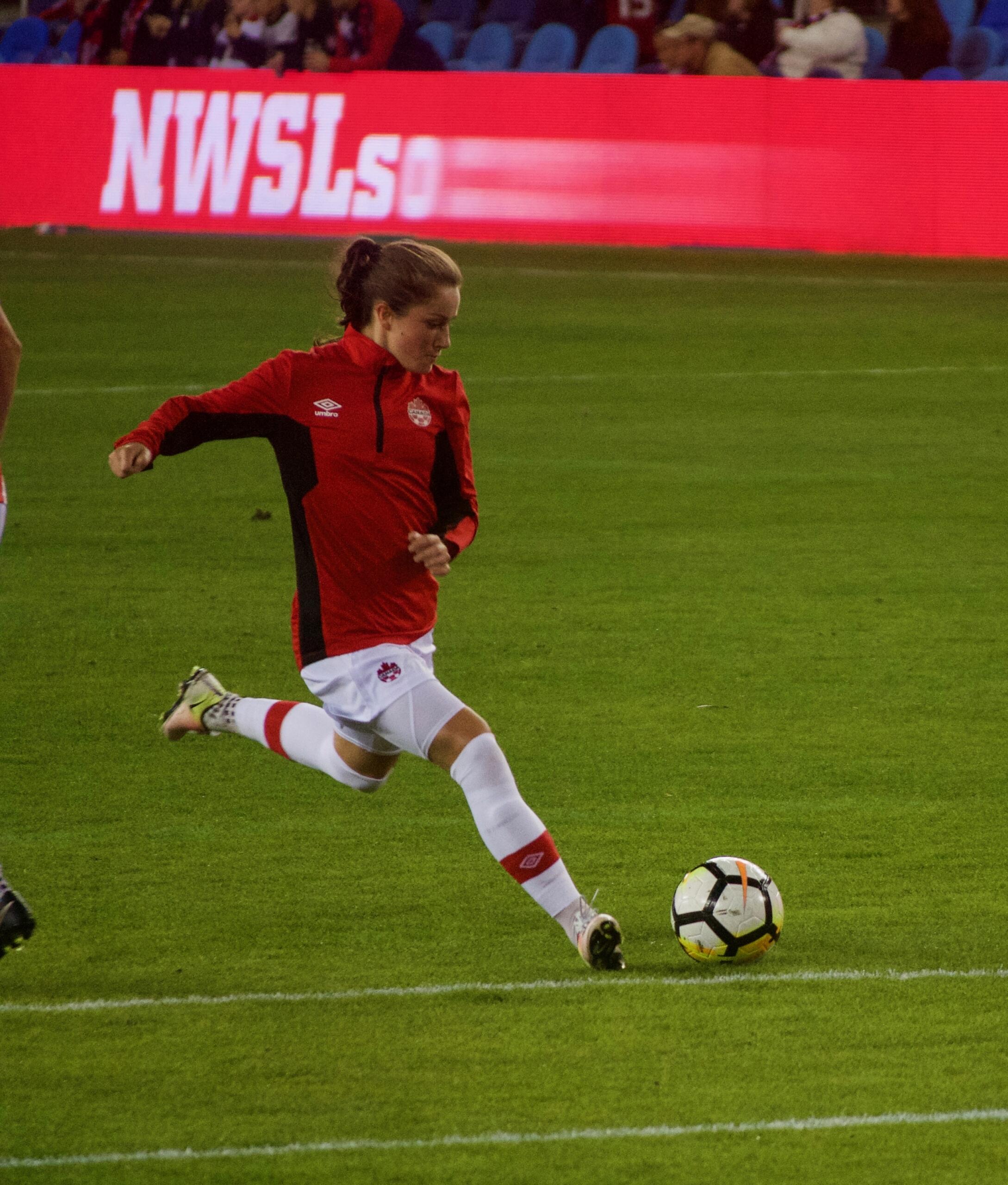Soccer is thriving in Canada, with professional teams and national squads making waves both domestically and internationally. This guide provides an overview of Canadian soccer teams, from the national teams to professional clubs in domestic and international leagues.

Canada’s National Soccer Teams
Canada is home to a growing network of national soccer teams that represent the country at the highest levels of international competition. Governed by Canada Soccer, these teams include the Men’s National Team (CanMNT), the Women’s National Team (CanWNT), and various youth and para soccer teams that showcase the country’s talent on global stages. Together, they form the backbone of soccer in Canada, driving interest, participation, and pride from coast to coast.
The Canadian men’s soccer team has experienced a remarkable rise in recent years. After their historic qualification for the FIFA World Cup 2022 — the first since 1986 — national enthusiasm surged. The team is now preparing to compete in its third World Cup, set to take place on home soil as part of the 2026 World Cup, co-hosted by Canada, the U.S., and Mexico.
Their growing resume includes three Concacaf titles (1985, 2000, 2022), a past appearance in the FIFA Confederations Cup, and an upcoming debut in the 2024 Copa América — a significant step onto the South American stage.
Star players such as Alphonso Davies, Jonathan David, and Cyle Larin are playing in top European leagues, turning international attention toward Canadian soccer players and proving that Canada can develop world-class talent. These achievements are deeply connected to the country’s expanding infrastructure, including youth development programs and the growing Canadian Premier League expansion, which is creating more opportunities for homegrown talent to rise through the ranks.
Canada’s women’s national team is one of the most accomplished and respected in the world. With a gold medal from the Tokyo 2020 Olympics, two Olympic bronze medals (2012, 2016), and two Concacaf championships (1998, 2010), the team has consistently ranked among the global elite.
They’ve qualified for every FIFA Women’s World Cup since 1995 and are set to compete in the 2024 Olympic Games in Paris. Players like Christine Sinclair, Jessie Fleming, and Kadeisha Buchanan have become international icons, both for their performance and for their advocacy in shaping the future of the sport.
Canadian Teams in Major League Soccer (MLS)
Canada is home to three professional clubs in Major League Soccer (MLS): Toronto FC, Vancouver Whitecaps FC, and CF Montréal. These teams represent the country on a major North American stage and have helped raise the profile of soccer in Canada through consistent competition, fan engagement, and player development.
Toronto FC (TFC) is perhaps the most recognizable Canadian team in MLS. Their 2017 season was one for the history books — the club completed a domestic treble, winning the MLS Cup, the Supporters’ Shield, and the Canadian Championship. TFC remains a powerhouse in Canadian soccer, a club that many young players aspire to join.

Vancouver Whitecaps FC have also established a loyal following and strong presence in the league. With multiple Canadian Championship victories, the club has earned spots in the CONCACAF Champions League and continues to invest in youth development and academy programs.
Meanwhile, CF Montréal, formerly known as the Montreal Impact, is recognized for its tactical approach and fierce competitiveness. The team reached the final of the CONCACAF Champions League in 2015 — the first Canadian MLS club to do so. Their rivalry with Toronto FC, known as the Canadian Classique, is one of the most intense matchups in Canadian sports, drawing national attention every season.
These teams play a key role in growing soccer in Canada, building player pathways and fostering passionate local fan communities.
Canada has 3 MLS teams and 8 Canadian Premier League teams, all contributing to a growing national soccer scene with rising talent and tighter league tables.

Canadian Premier League (CPL) Teams
The Canadian Premier League (CPL), launched in 2019, represents a major milestone for professional soccer in Canada. Designed as the country’s own top-tier league, the CPL was created to spotlight Canadian talent, build regional pride, and offer young players a clear path from grassroots soccer to the professional stage.
With CPL clubs like Forge FC, Pacific FC, Cavalry FC, and York United FC, the league is expanding its reach and reputation each season. These clubs not only compete fiercely on the field, but also play a vital role in community development, fan engagement, and youth mentorship. CPL matches are now a regular part of the Canadian sports calendar, contributing to a more vibrant and inclusive soccer culture nationwide.
The Canadian Premier League table evolves quickly, with tight competition and emerging stars shaping the standings. Fans following the Canadian soccer league standings are increasingly excited by the level of play and potential of domestic athletes. However, this is the current Canadian Premier League table as of 2025:
| Position | Team | Played | Wins | Draws | Losses | Goals For | Goals Against | Goal Difference | Points |
|---|---|---|---|---|---|---|---|---|---|
| 1 | Atlético Ottawa | 8 | 5 | 2 | 1 | 22 | 13 | +9 | 17 |
| 2 | HFX Wanderers FC | 8 | 5 | 2 | 1 | 12 | 7 | +5 | 17 |
| 3 | Cavalry FC | 7 | 4 | 1 | 2 | 15 | 6 | +9 | 13 |
| 4 | Forge FC | 7 | 3 | 4 | 0 | 9 | 5 | +4 | 13 |
| 5 | York United FC | 8 | 2 | 1 | 5 | 11 | 13 | -2 | 7 |
| 6 | Pacific FC | 8 | 2 | 1 | 5 | 7 | 15 | -8 | 7 |
| 7 | Vancouver FC | 7 | 1 | 2 | 4 | 6 | 12 | -6 | 5 |
| 8 | Valour FC | 7 | 1 | 1 | 5 | 6 | 17 | -11 | 4 |
Looking ahead, the CPL is expected to be a key contributor to Canada’s success at the 2026 World Cup, which the country will co-host. Many hope that players nurtured within the league will rise to represent Canada on the world stage — a clear sign that domestic infrastructure is finally catching up with national ambition.
Women’s Professional Soccer in Canada
Despite Canada’s long-standing success on the international stage, the country still lacks a domestic professional women’s soccer league.
While the Canadian Premier League table tracks the growth of men’s pro soccer, no equivalent currently exists for women. This absence has fueled calls for structural change, with increased momentum behind the proposed Canadian Women’s Professional Soccer League (CANWPL) — an initiative that aims to provide homegrown players with more opportunities to compete at a professional level within Canada.

Currently, many Canadian players are forced to look abroad to pursue professional careers.
Standout talents like Jessie Fleming (Chelsea FC) and Kadeisha Buchanan (Olympique Lyonnais) are excelling in top-tier European clubs, raising the international profile of Canadian soccer players and highlighting the need for domestic infrastructure to match their skills and ambitions.
Canada Soccer’s commitment to youth development is evident in its U-20 and U-17 national teams, which regularly compete in FIFA Women’s World Cup age-group tournaments and the Concacaf Championships. These programs help develop elite talent, but without a national league, the pathway remains incomplete.
Coaching leadership also plays a crucial role in shaping the future of Canada’s women’s soccer. In May 2024, Casey Stoney was appointed as the new head coach of the Women’s National Team. A respected former England international and successful coach in the NWSL, Stoney brings deep experience and a fresh strategic perspective to a team already rich in legacy. Her arrival signals Canada Soccer’s commitment to long-term development and competitive excellence as the team looks ahead to the 2024 Olympics and future FIFA Women’s World Cups.
Under her leadership, there is growing optimism that the team can build on past successes — including the Tokyo 2020 Olympic gold medal and back-to-back bronze medals at London 2012 and Rio 2016 — while also pushing for more consistent top-tier performances on the global stage.
Canada has participated in eight consecutive FIFA Women’s World Cups (1995–2023) and five straight Olympic Games (2008–2024) — a legacy unmatched by many countries with established pro leagues.
As support for women’s soccer continues to grow, the establishment of a national league could prove to be a defining moment for soccer in Canada, creating a more complete ecosystem for young athletes wanting to become pro soccer players and inspiring the next generation of stars.
Supporting Canadian soccer teams
Behind every great team is a passionate community of fans, and in Canada, that support is growing stronger with every match. Whether you’re cheering from the stands or streaming a game online, getting involved with your favorite club helps fuel the future of the sport.
Attending a championship game at your local stadium, joining a supporter group, or even following teams on social media are all ways fans are shaping the next chapter of Canadian sports.

From Vancouver to Halifax, cities are seeing increased turnout and enthusiasm at matches. This momentum isn’t just about what happens during the final whistle — many teams invest heavily in community outreach, including youth programs and soccer clinics that inspire the next generation.
By showing up and staying engaged, fans are helping Canadian soccer teams gain attention in national news, attract sponsorships, and make bigger impacts in both domestic and international games.
Whether it’s in your city or across the country, every voice in the crowd brings Canadian soccer one step closer to becoming a global force.
As Canada prepares to take the global stage at the 2026 World Cup, the role of fans has never been more vital. Supporting Canadian soccer teams — in the stands, online, or in your community — isn’t just about watching a game. It’s about being part of a growing movement that’s reshaping the future of sports in Canada. The energy, pride, and unity fans bring today will echo in every goal, every match, and every stadium tomorrow.















